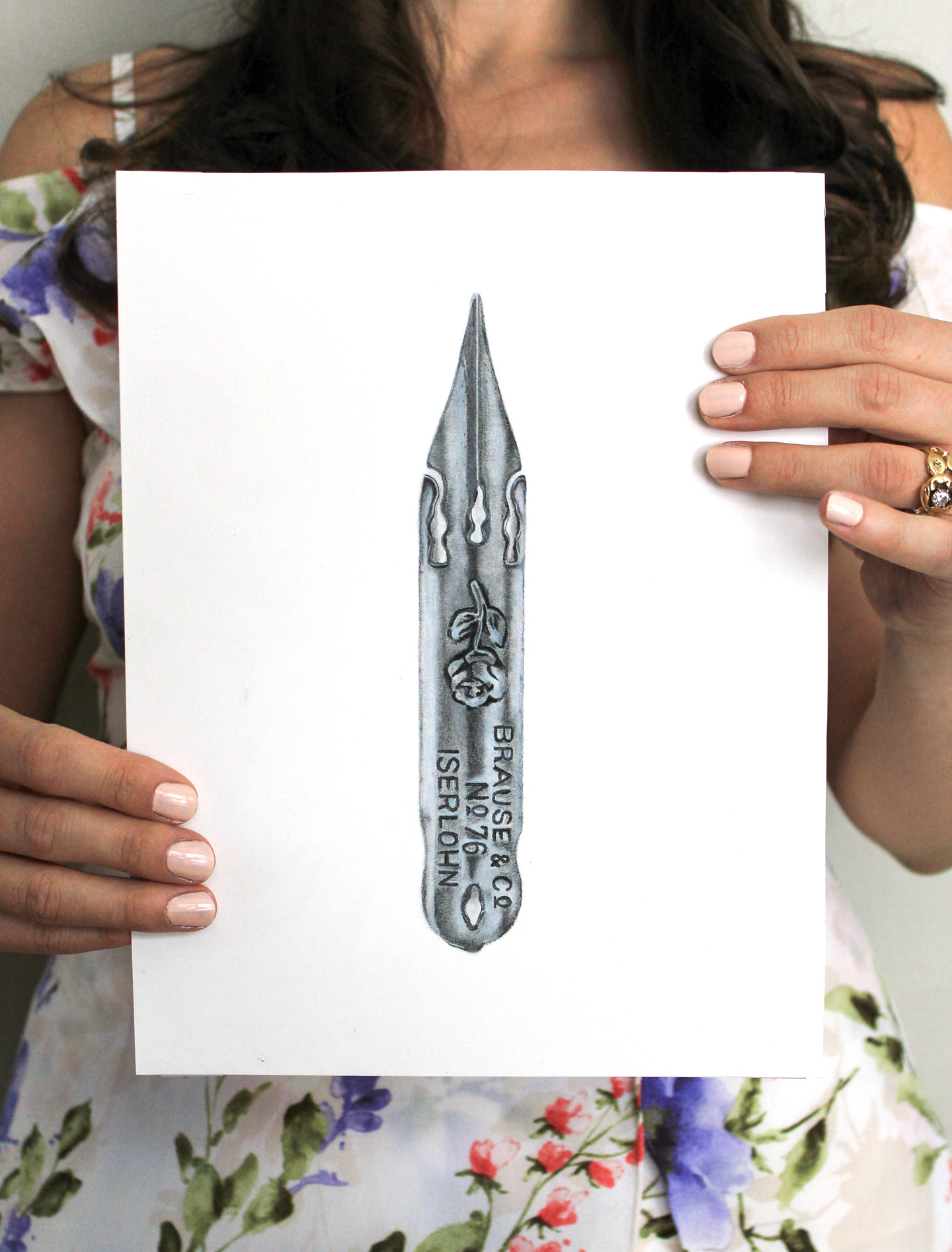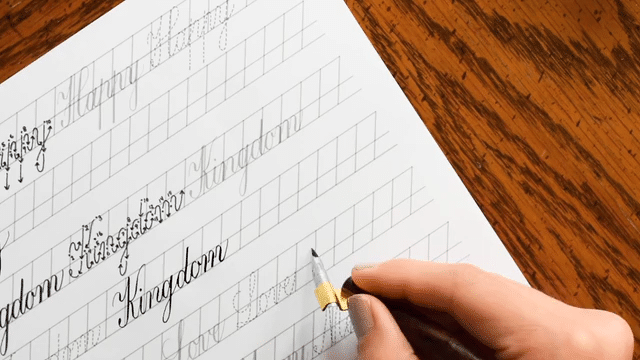
If you’ve been following TPK on Facebook or Instagram, you know that I’ve been drawing on black paper for the past two weeks working on my chalk-style illustration booklet/kit for Quarto Publishing. The kit will be available on Amazon and in various brick-and-mortar stores late summer of this year, but I couldn’t wait that long to write a blog post over this — actually, very fun — activity.

Drawing on black paper is a novelty. I think it’s appealing for a couple of reasons, the first of which being it’s hard to do if you don’t have the tools {which are somewhat specialized}. Creating artwork on black paper is impressive because it says: “Look at this cool pen/thing I have, and the stuff I can do with it!” The second reason is the fact that it’s difficult for a printer to mass-produce. By and large, printers can only print colored inks, which means printing white on black paper hardly ever happens {unless a printing company has a special printer}. So: when you send someone artwork on black paper, it immediately says: “I took the time to make this especially for you by hand.” Mainly, though, artwork on black paper just looks cool, which is why I’m writing this blog post.
I am going to show you a few tools and techniques for writing and drawing on black paper; for all of them, I’d recommend getting one of these little guys:

The tool pictured in the image above has been my savior the past couple of weeks. It’s a soapstone pencil, and it’s my new this-is-amazing find {well, when it comes to writing on dark paper}. Usually, soapstone is used by quilters who want to mark on fabric. However, you can use it to mark guidelines or make a design draft on dark paper. The best part? You don’t even have to erase it. It actually will just rub away with a soft cloth, which reduces the chances of your ink smudging.
First, let’s go over the technique that I was using for the Quarto booklet. It requires basic tools and no knowledge of dip pen calligraphy. First, you’ll want to procure a Sakura Gellyroll white pen.

I linked to Amazon, but they’re available individually for $1.50 apiece-ish at most craft stores.
Next, whip out your colored pencils.

Begin by using your soapstone pencil to draw your design. I’m on a jewel kick, so I drew a simple diamond outline below, which you are more than welcome to do as well.

{I have included measurements for your reference in the image below.}

Next, take your colored pencil and fill in the areas you wish to have color. It is important that you do this before you add the white ink; if you wait and do it afterward, the design won’t look as clean because color from the colored pencils will inevitably color over/tint some of your white ink.


Once you’ve added color to your paper, prepare your gel pen for use by getting its ink flowing on a piece of scrap paper. This step isn’t totally necessary, but it’s helpful because sometimes ink from previous uses coagulates on the nib and makes the starting point look funky on your final art piece.

Now, simply trace over your soapstone lines …

Once you’re finished tracing, rub your soapstone markings away with a soft cloth. {Alternatively, you can use a rubber eraser.} The finished product will be a design that’s worthy of a Whole Foods chalkboard. If you’re confused on how to make the strong typography on this piece, hang tight for a couple of weeks! I’m working on a Learn for a Latté worksheet set covering typography.

I also really like leafing pens for making drawings on black paper.

These pens are really just paint in marker form. You have to toy with them a bit to start the flow, but the results are worth it!

This simple design and color scheme looks like something you would see framed with a large white mat in an ultramodern home. You can, of course, use it for that purpose {and if you do, tell people you purchased it at an art gallery for thousands of dollars}, or just send it as a minimalistic greeting card. You could write a message over it with your Gellyroll pen, if you are so inclined!

The thing that sets the leafing pens apart is the beautiful sheen … these dots actually have the appearance of tiny, shiny pennies that react to the light.

If you do buy a leafing pen, you can also use it to draw metallic borders on envelopes, place cards, or whatever else. The package the pen comes in says you can even use it on furniture, but I haven’t gotten that brave yet!
Moving on, the two projects I just wrote about use techniques/tools that don’t require knowledge of a calligraphy/dip pen. The next materials I am covering do require such knowledge — but, really, if you don’t know how to use a calligraphy pen, it’s quite simple, and I do heartily encourage you to learn! Below you can see all the supplies you could use to create calligraphy or drawings on black paper. Most assuredly there are more black-paper friendly supplies out there in the whole wide world, but this is what I’m covering today.

My go-to choice for writing on black paper is Winsor & Newton white ink. I have heard a lot of good things about Dr. Ph. Martin’s white ink, but, you know, I haven’t run out of this ink yet, so I haven’t purchased any Dr. Martin’s to compare. From what I have read about the Martin’s, you use it the same way as you use this ink, and it has the same quirks.

You may wonder what I mean by “quirks”. The first quirk is this: out of the box, this ink may be a little too runny to comfortably {and opaquely} use. To take care of that problem, you can leave the ink out for a couple of hours with the lid off so some of the liquid can evaporate out. Your white ink should have a consistency that’s halfway between fat-free yogurt and cream. The other quirk is this ink has a tendency to get a little too thick at times. That’s really no problem, just add water, twist the lid on, and shake it up! I’m adding water to my ink below:

There are some nibs that play nicer with white ink than others. My favorite choice for writing with white ink is the Brause Rose nib because it’s hardy/broad enough to handle more viscous inks.

However, you can use just about any nib. The only one I had a lot of trouble with was the Nikko G, for whatever reason. I didn’t include it on the list below because — truly — the results were terrible. The nib just didn’t seem to be flexible enough to work well with the white; but the trouble could very well be the user rather than the tools!

Since white ink is more or less simply acrylic paint, you can use it to write on any paper surface! I love making envelopes out of vintage magazine pages, so I’m always using white ink to write on the magazine’s smooth surface {which Gellyroll ink would never stick to}.

I know I’ve mentioned gold ink several times in the TPK blog, but you can never talk about the Finetec palette too much. To start, moisten your paint with a drop or two of water.

After the water has had some time to soak in {3-ish minutes is ideal}, stir it up with a brush. The consistency you’re going for isn’t quite as thick as the consistency you want with white ink … you’re looking for the consistency of cream here.

Once you’ve reached the ideal consistency and are ready to write, brush the gold on to the back of your nib as pictured below, then write!

As you can see, these golds are shiny, opaque, and wonderful. They can write words {as pictured below} or simply accent illustrations … whatever you want, really!

The last thing I’m going to talk about is gouache. As a full disclaimer, I barely use the stuff because it just seems like a hassle to me. However, there are a lot of calligraphers I admire {Albrecht Clauss among them} who use gouache beautifully and with ease. I, unfortunately, don’t get the same vivid results, but it may just be my crummy Walmart gouache set.
To prepare your gouache for writing, squirt some out into a vessel like a paint palette or a shot glass.

Add a little bit of water …

Then mix until you’ve got that consistency between cream and low-fat yogurt. {Come to think of it … the way I am attempting to describe the consistency may be “drinkable yogurt”, which isn’t that popular in the US, but if you’re outside the US, you might be familiar with it.}

Gouache works the same way as writing with the Finetec golds; it needs to be brushed on the back of the nib.

Then you can use it to write with!

I personally get kind of a dull, matte result from working with gouache, but I am sure that higher-quality gouaches — which have much better, more vivid pigments — would render more brilliant results. At any rate, if you’re interested in writing in some unique colors on black paper, gouache is a great choice!
Lastly, you may wonder where to procure black card stock. Honestly, all I do is purchase 8.5″x11″ {standard printer size} sheets at craft stores, then I cut them to whatever size I want. It’s a good, economical system, and it allows you to make an A7 card one day and an A4 card the next!

I hope you were inspired by this post, and if you have any thoughts on creating drawings on black paper, let me and others know in the comments! I’d love to hear if you have tried the Dr. Ph. Martin’s ink, and if so, what you think; what your experience is working with gouache on black paper; and/or if you have any other fun ideas for drawing on black paper!
Thanks very much for reading; talk to you again soon!
Warmest wishes,

*This post contains affiliate links to Amazon



































